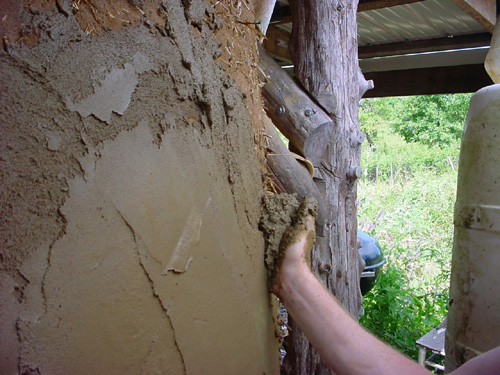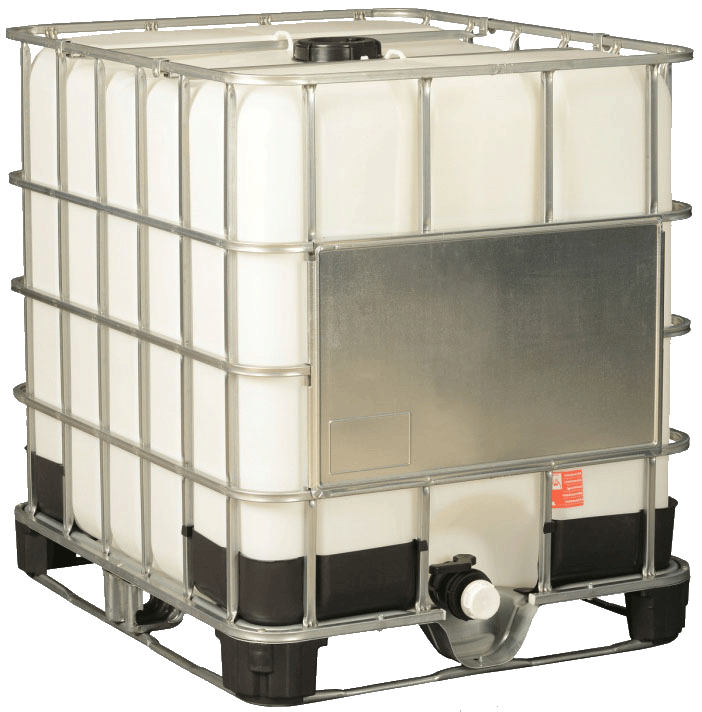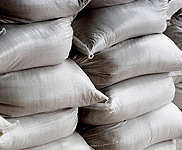
|
Plastering Plastering is the necessary skin that protects your earthbag walls from the elements. (In much of the world, "plastering" refers to the interior walls and "rendering" refers to the outside walls.  Here in the US, it's all called plastering.) Polypropylene
bags - despite being treated with UV inhibitors - will start
deteriorating after just a few months in the sun, exposing
the baked contents to erosion. Burlap bags will get bleached
& weakened by the sun, abraded by wind & sand &
silt, rotted from moisture, and eaten or harvested for
nesting by insects, birds & animals. You need to
plaster.
Here in the US, it's all called plastering.) Polypropylene
bags - despite being treated with UV inhibitors - will start
deteriorating after just a few months in the sun, exposing
the baked contents to erosion. Burlap bags will get bleached
& weakened by the sun, abraded by wind & sand &
silt, rotted from moisture, and eaten or harvested for
nesting by insects, birds & animals. You need to
plaster. Besides being protection for the bare bones of your structure, plaster is your structure's skin. It's here that you can play with color, texture, adornment (inlaying stone, tile, glass, or adding mica to your mix). And it's here that you can achieve those rounded corners and sweeping curves that probably attracted you to earthbag construction in the first place. It's not in our scope to provide a comprehensive tutorial on plastering. There are good resources out there; see the book suggestions at the bottom of this page. It isn't rocket science. People have been plastering their structures for about 12,000 years, and continue to do so today in many parts of the world. Like building with earthbags, it's pretty intuitive, and you'll quickly begin to get a feel for it. Basic earth plaster: Your base plaster can be the same mud as your earthbag fill, though you may want to tweak it as needed by adding a little straw, sand, clay and/or manure (see below). Just as we advise that you experiment with your bag fill to get it right before getting started (jar test, sample clumps, etc.) so we advise that you do the same with your plaster mix well in advance. Mix small quantities and plaster a couple of cinder blocks or 2x4s, whatever, then leave them outside & let the weather have its way with them. All the better if you do this several months before building commences so that your samples will have had a chance to get a little beat up by the sun, rain, UV, snow, wind, etc. You'll basically be looking at plastering in at least two different layers and with two different compositions: a thick base layer and a thin finish layer. Your base plaster (the thickest) should be built up in several relatively thin, incremental layers. Glomming on too much base plaster at once (a 1", 2", 3" layer of goopy plaster all at once) may lead to catastrophic failure. Imagine a clump shifting, swelling, pressing out against your finish layer & causing it to crack, allowing water to get in, and then compromising everything. You can and should make your base plaster much more bomb-proof by laminating it, grooving each layer with a trowel to give successive layers "tooth" to stick to, adding sand to your plaster for grit (which also creates tooth, giving the next layer to adhere to), and doing what you can to make your plaster as sticky as possible by adding the likes of clay, wheat flour or manure. The simplest earth plaster for the base layer is essentially earth, sand, and straw, (or manure, or cellulose, for binder). You'll want your earth to have at least 20% clay. Too much clay = a tendency for your plaster to swell, contract & crack. Your sand should be plastering sand, meaning that the granules are angular & lock together (rather than beach sand, which has rounded granules). A good place to start if you're making it from scratch is two parts clay-rich soil, two parts chopped straw (about 1" long pieces; a weed eater and a steel barrel work great), one part sand, and then add water to desired consistency. If you're using native soil, get a handle on how much sand-to-clay you have and consider bumping up one or the other. Again, refer to the jar test. Experiment for best results. Factors like the variability of soils, daytime & nighttime temperatures, humidity, etc. all make it impossible to develop a one-size-fits-all recipe for plaster that works for everyone.  Plastering
requires
a water source close at hand. Some people we've worked with
have done their building in areas without water (having to
drive for miles to fill up jugs from rivers & creeks).
If you're working on a large scale, consider investing in an
IBC tote ("intermediate bulk container"). These come in 275
gallon & 330 gallon sizes, and can be found used for
$150 - $200, or $250-$300 new. We can get them for you if
you can't find a source. After construction, they'll provide
lasting value for drinking water or to store grey water. Plastering
requires
a water source close at hand. Some people we've worked with
have done their building in areas without water (having to
drive for miles to fill up jugs from rivers & creeks).
If you're working on a large scale, consider investing in an
IBC tote ("intermediate bulk container"). These come in 275
gallon & 330 gallon sizes, and can be found used for
$150 - $200, or $250-$300 new. We can get them for you if
you can't find a source. After construction, they'll provide
lasting value for drinking water or to store grey water.If you buy a used IBC, make sure to determine what was in it before (you don't want one that was previously used with solvents or chemicals). They're in a metal cage, and fit in the back of a pickup. Do be aware that water weighs a little over 8 lbs per gallon, and at over a ton a filled 275 gallon tote (filled with sloshing water on an unimproved road leading to your site) can strain your truck's suspension. Base layers:  You'll
notice
that the face of your stacked earthbag construction is
scalloped, having rounded edges alternating with V-shaped
crevasses. You'll first want to fill these in. How well (or
how sloppily) you laid & tamped your bags will have a
lot of bearing on how deep those crevasses are; and how well
you fill these in will define how well your external
plastering will hold up. You'll
notice
that the face of your stacked earthbag construction is
scalloped, having rounded edges alternating with V-shaped
crevasses. You'll first want to fill these in. How well (or
how sloppily) you laid & tamped your bags will have a
lot of bearing on how deep those crevasses are; and how well
you fill these in will define how well your external
plastering will hold up. Mix your plaster in a wheelbarrow, turning it with a shovel. A masonry hoe is a good investment - they're heavy duty & have two big holes in the blade. Or get a paint-mixer attachment (like a giant eggbeater) for your powerful and low RPM power drill. If you have a big job, you can always rent, beg, borrow, or buy a cement mixer. Or if you're trying to keep costs down, you can throw a party; toss a tarp on the ground, dump your ingredients, wet it all down, put on some music, and have everyone mix it & squish it with their bare feet. (Kids especially love this.) Then put everyone to work. Start by packing your base plaster in with your hands, glomming it on & pushing it in with your fingers. Again, consider doing it in increments; an inch or so, give it a few hours or a day to set, add another layer, let it set. If you have lots of spaces in the crevices that you can't reach, then pack as much soggy plaster as you can, using your fingers to get into the crevices then switch to your hands & your trowel as the face flattens. Plastering's best done on hot days. Keep a bucket of water nearby and add some to your plaster mix when it starts to dry out or gets crumbly. A squirt bottle close at hand can also be helpful. Once your plaster mix has had a chance to cure (it'll be pretty hard), you can add the second layer of your base plaster, which will completely cover your bags. You'll want to groove with a trowel to give some "teeth" for the finish plaster to key into (this is called the "scratch coat"). You can opt to cover your bags with some sort of mesh after filling your bags' crevices. Commonly used are chicken wire, metal lath, & plastic mesh. If you choose to do this, you'll want to apply a second coat of your base plaster (referred to as the "brown coat"), finishing it smooth in preparation for the finish layer. Finish layer: Besides defining texture & color, your finish layer provides all-important weatherproofing. A basic finish plaster will consist of finely-sifted dirt (a 1/8" screen is good) with the same basic 20-30% clay content, plus perhaps more sand added than you'd be using for your bag fill & your base plasters. When sifting, it's pretty critical to remove all organic material (fine root clusters, seeds) so you don't have things growing out of it. You can also add a variety of sealants (wheat flour paste, egg whites, linseed oil, etc.) which will give it a fair degree of water repellancy and help decrease the need to re-plaster every year or two. You can add cement and/or lime to natural plasters (up to, say, 10%), but it's a trade-off; what you gain in strength, you lose in elasticity (crack resistance) and breathability. Lime is another option, as is stucco or papercrete. The latter are both cement-based, which is good in humid climates, but they don't breathe, meaning that any humidity or water that get inside your walls can soften your earthbags over time & compromise your structural integrity. There's a little more discussion about these further down the page, but - again - this is just an introduction and you're advised to dig deeper or pick up one of the excellent books (see the bottom of the page) that are available. When choosing what kind of finish layer to use, consider the following: Climate:
You can add pigments to your finish layer for color (here's one site we like). Methods range from slathering it & smoothing it by hand or trowel, to pump & spray applications with rental equipment. If you want a professionally-finished look, you shouldn't have much trouble finding contractors to handle this phase for you... but you'll want to be clear with them about what materials they use. Plastering as you go:This is a little controversial, and you'll need to use your best judgement. Ideally, you want your bags to be fully cured before applying plaster (which otherwise will keep moisture inside your walls - you don't want that).It is possible to alternate between filling/stacking bags and plastering, perhaps switching off every few days. There are four benefits to doing so:
So, what to use? Once you start looking, you'll discover that there's a lot of discussion & even a little controversy over the pros & cons of various materials. Here are just a few, with some links: Earth plaster Basically high clay-content soil, sand, binder, and water. New Mexico Clay has a good line of clay additives (if your soil isn't up to par), and Dancing Rabbit has a very nice page on techniques. Click here for a YouTube video on natural & food-based additives for mud plaster finish layering. (A few examples include milk, wheat flour, and egg whites.) Lime plaster Besides having a beautiful finish, lime has the virtue of being flexible after it's cured and offering breathability. It's essentially lime (binder) mixed with sand (aggregate) and water. A bit complicated to use (buy hydraulic, not hydrated). It's caustic and hard on the skin... so, goggles, gloves, and long sleeves are called for. An excellent resource is Barbara Jones' article "Working with Lime" inThe Art of Natural Building. Limewash is an easier application to mix & use over a finished plaster. The National Lime Association offers a great article on this here (PDF download). Papercrete A mix of Portland cement, paper & water. Sand can be added to the final coat for texture. Rumored to be prone to black mold growth if exposed to moisture (not that much of a problem here in NM). There's a discussion that touches on it at Autonotopia, while Gordon Solberg of Las Cruces offers his book and DVD, Building with Papercrete & Paper Adobe, here. Stucco By contemporary definition, stucco contains cement. It may contain lime (for flexibility), but most stucco used today is basically cement, sand, and coloring. Widely available for purchase and for application by contractors. Aliz Also referred to as clay slip. Less of a plaster and more of a clay-based finish paint for indoor use, which may offer a greater range of colors & tints to choose from. New Mexico Clay has a page on aliz here, and you can also find more on the Web. For a much more detailed exploration, we suggest: The
Natural
Plaster Book by Cedar Rose Guelberth and Dan
Chiras. and
Clay Culture: Plasters, Paints and Preservation by Carole Crews. |